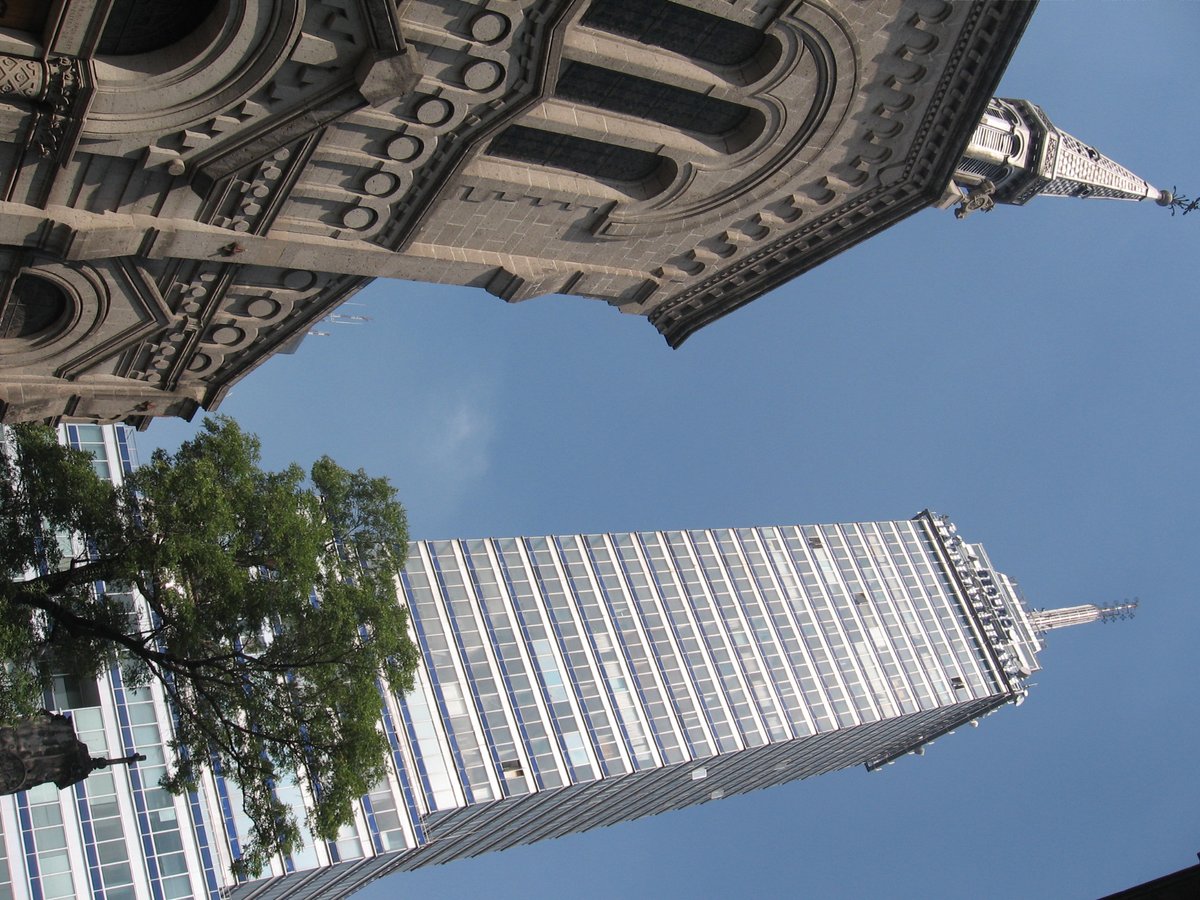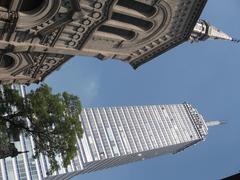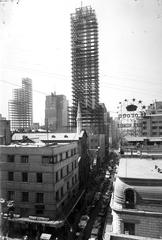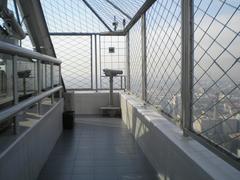
Torre Latinoamericana Mexico City: Visiting Hours, Tickets, and Historical Sites Guide
Date: 14/06/2025
Introduction
Rising above the heart of Mexico City’s historic center, the Torre Latinoamericana is an enduring symbol of Mexico’s resilience, ingenuity, and urban progress. Completed in 1956, this iconic skyscraper not only marked a new era of architectural ambition for Latin America, but also set global standards in earthquake-resistant design. Built atop the challenging sediments of a former lakebed, its innovative engineering has enabled it to survive some of the city’s most powerful earthquakes unscathed—a feat that continues to inspire architects and visitors alike (miradorlatino.com; great-towers.com; Mexico City Government).
Beyond its technical achievements, Torre Latinoamericana stands as a cultural beacon for Mexico City. Its striking glass and aluminum façade, panoramic observation deck, and central location have made it a must-visit for travelers, history enthusiasts, and locals. This guide offers a detailed overview of the tower’s history, visiting hours, ticketing options, accessibility features, nearby attractions, and travel tips to help you make the most of your visit (touristplatform.com; yourfriendthenomad.com).
Table of Contents
- Introduction
- Historical Background
- Visiting Information
- Architectural and Technical Details
- Milestones and Renovations
- Legacy and Cultural Significance
- FAQs
- Travel Tips
- References
Historical Background
Origins and Vision
The tower’s story begins at the crossroads of Avenida Juárez and Eje Central, on a site once occupied by the Casa de las Fieras de Moctezuma—the Aztec emperor’s menagerie (miradorlatino.com). In the mid-20th century, as Mexico City modernized, the insurance company La Latinoamericana Seguros, S.A. envisioned a skyscraper that would exemplify progress and resilience. The project was spearheaded by Lic. Miguel S. Macedo, with architect Augusto H. Álvarez and engineer Adolfo Zeevaert Wiechers leading the design, and seismic consultation by Nathan Mortimore Newmark (miradorlatino.com).
Construction and Engineering Feats
Started in the early 1950s and inaugurated on April 30, 1956, the Torre Latinoamericana soared to 181.33 meters (595 feet) and 44 floors, becoming the tallest building in Latin America and the highest skyscraper outside the U.S. at the time (miradorlatino.com; casadechiles.com).
Key engineering highlights include:
- Seismic Innovation: Built on soft former lakebed soils, it was the world’s first skyscraper designed to withstand earthquakes in such a zone. Its steel frame and deep pile foundations absorb seismic energy (miradorlatino.com).
- Modernist Materials: First Mexican building with a glass and aluminum façade.
- Advanced Elevators: Seven high-speed elevators traveled from ground to the 37th floor in under 30 seconds (miradorlatino.com).
Earthquake Survival and International Recognition
The Torre Latinoamericana’s engineering was tested—and celebrated—after surviving major earthquakes. It withstood the 1957 quake without damage, earning international awards for seismic resilience (miradorlatino.com). The catastrophic 1985 earthquake, which devastated much of the city, left the tower unharmed, reinforcing its reputation as one of the world’s safest tall buildings (miradorlatino.com; casadechiles.com).
Urban and Cultural Impact
For over 25 years, the Torre Latinoamericana dominated Mexico City’s skyline. Its central location made it a focal point for locals and tourists, while its appearance in art, film, and literature cemented its place in Mexico’s cultural imagination (casadechiles.com). The observation deck offers unmatched vistas over the city, connecting visitors to its history and geography (miradorlatino.com; casadechiles.com).
Visiting Torre Latinoamericana: Practical Information
Opening Hours
- Daily: 9:00 AM – 10:00 PM
- Last Entry: 9:00 PM
Hours may vary on holidays; check the official website for updates.
Tickets and Prices
- Adults (12+): ~MXN 225
- Children (4–11): ~MXN 175
- Infants (0–3): Free
- Combo Tickets: Include observation deck and Museo Bicentenario (36th floor)
- Discounts: Available for seniors, students, and children
- Purchase: Online (recommended) or at the entrance; e-tickets accepted (tiqets.com)
Accessibility
- Elevators to all public floors.
- Wheelchair accessible, though the final stairs to the open-air deck may limit access—staff assistance is available.
- Accessible restrooms and ramps.
Guided Tours & Special Events
- Free guided tours (English/Spanish) can be reserved from the 37th floor.
- Cultural exhibitions, light shows, and events are held periodically (Mexico City Government).
Nearby Attractions & Photography Spots
- Palacio de Bellas Artes: Across the street.
- Alameda Central: Historic public park adjacent to the tower.
- Zócalo: Mexico City’s main square, a short walk away (charcotrip.com).
- Museo del Templo Mayor and the city’s historic walking routes.
The observation deck provides 360-degree city views, ideal for photography—visit at sunset or at night for city lights (icouldshowyoutheworld.com).
Architectural and Technical Details
- Height: 181.33 meters (595 ft) including antenna
- Floors: 44 above ground
- Elevators: 7, max speed 4 m/s
- Staircases: 916 steps
- Constructed Area: 27,727 m²
- Water Storage: 250,000 liters
- Facade: Glass and aluminum
- Foundation: 361 concrete piles, 33 meters deep
- Seismic Design: Deep piles and steel frame—pioneering for its era (great-towers.com)
Milestones and Renovations
- 50th Anniversary (2006): Remodeled floors 38–44 and inaugurated an onsite museum (miradorlatino.com).
- Recognition: Awarded by the American Institute of Steel Construction and IMEI for engineering excellence.
- Future Plans: Façade updates with modern materials while preserving its legal status as an artistic and historical monument.
Legacy and Cultural Significance
Torre Latinoamericana remains one of Mexico City’s most beloved landmarks, not only for its seismic engineering but also as a symbol of the city’s progress and cultural pride. Its central role in the city’s skyline and its accessibility to all visitors have ensured its ongoing popularity (miradorlatino.com; casadechiles.com). Through exhibitions, restaurants like Miralto, and panoramic experiences, the tower continues to bridge Mexico’s rich past with its dynamic present.
Frequently Asked Questions (FAQs)
Q: What are the Torre Latinoamericana visiting hours?
A: Daily, 9:00 AM–10:00 PM (last entry 9:00 PM).
Q: How much do tickets cost?
A: Adults ~MXN 225; children ~MXN 175; infants free; discounts and combo tickets available.
Q: Is the tower wheelchair accessible?
A: Yes, except for a short stairway to the open-air deck; staff can assist.
Q: Are guided tours available?
A: Yes, free guided tours in Spanish and English can be reserved onsite.
Q: What’s the best time to visit?
A: Weekday mornings for fewer crowds; sunset for city lights and photos.
Travel Tips
- Arrive early for fewer crowds and best lighting.
- Check weather for clear views, especially of distant volcanoes.
- Bring a camera; tripods may be restricted during peak hours.
- Combine your visit with Palacio de Bellas Artes, Alameda Central, or the Zócalo.
- Use public transport: Metro Bellas Artes (Lines 2 and 8) is nearby.
- Stay updated on special events and guided tours through the official website or Audiala app.
References and External Links
- miradorlatino.com
- great-towers.com
- Mexico City Government
- yourfriendthenomad.com
- icouldshowyoutheworld.com
- casadechiles.com
- touristplatform.com
- Oxford Research Encyclopedias
- tiqets.com
- charcotrip.com













































































































































































